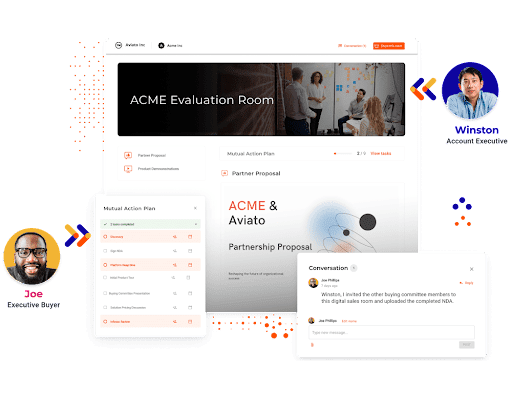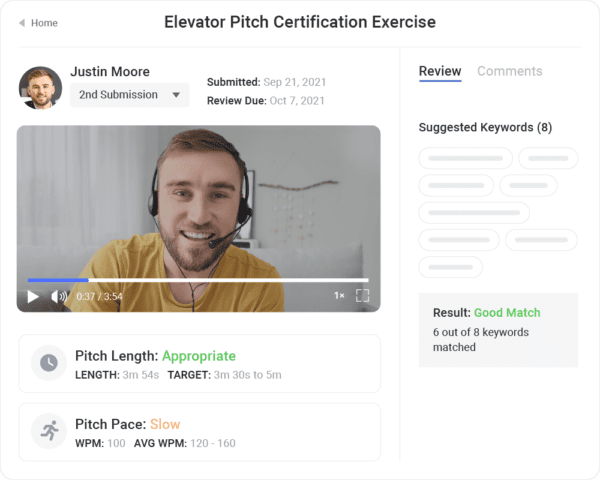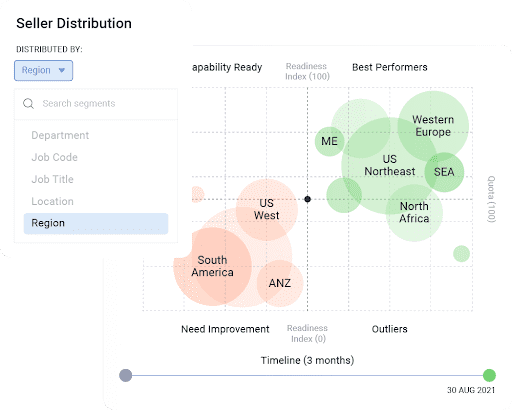In 2022, only 26% of sales reps reached 90% or more of their quota. That’s not a very successful win rate, especially when you consider the immense amount of money many sales organizations invest in tools that are meant to improve sales productivity. In fact, 28% of sales organizations use 10 or more sales tools to help reps get the job done. So the question is, what types of sales productivity tools actually drive a return and successfully help sales teams reach their quotas?
What is sales productivity?
Simply put, sales productivity is how efficient and effective your sales executives are at hitting various revenue milestones and goals. Of course, just because reps make more calls and send more emails does not necessarily mean they are progressing sales or generating revenue.
At Mindtickle, we define a sales productivity tool as anything that improves and measures the skills, will, and in-field behaviors demonstrated by reps.
That might include tools that hold reps accountable, such as email and call activity tracking; those that empower reps to better prepare for meetings and follow-up, such as Content Management Systems (CMS); and solutions that arm reps with insights that help them drive specific deals and accounts forward more effectively.
After reading this post, you’ll be able to understand:
- The advantages the right sales productivity tools can provide to your company
- The essential solutions and features to look out for when improving sales productivity at your company
- The top five sales productivity tool “must haves”
- Our recommendations and best practices
Why are sales productivity tools important for your business?
The most powerful benefit of sales productivity tools is that they help reps win more business by holding reps accountable, saving them time, and helping them deliver a better, faster customer experience.
This has a butterfly effect that improves revenue metrics like quota attainment, pipeline coverage, number of at bats, average contract value, average cycle time, and even the lifetime value of your customers.
At the same time, these tools align cross-functional members of revenue teams by providing a high degree of transparency and visibility while centralizing access to things like content, training, and insights.
With sales productivity tools, your team can do things like:
- Search for potential buyers to set meetings with them
- Grow, develop, and convert sales opportunities throughout the sales cycle
- Understand areas of opportunity to improve their performance
- Do more with less time and facilitate better hand-offs or deal collaboration
- Access content and insights that can help move deals forward faster and personalize the customer experience
- Learn from the winning attitudes and skills of top peers
- Keep up-to-date on new strategies, product launches, competitors, and market approaches
- Keep track of activity, pipeline, and progress toward goals
Modern sales productivity tools make your entire sales process more simple, measurable, and effective. This can result in benefits like:
- Faster onboarding and revenue contribution
- More opportunities in the pipeline
- Higher conversion and win rates
- Improved performance against competitors
- Better understanding of winning playbook
- Increased renewal rates
- Improved rep performance and retention
- Improved forecasting
- Tighter alignment around customer needs
And now, here are the top five sales productivity tool benefits:
1. Manual data entry & note-taking is eliminated
In 2023, the days of manually inputting deal data into Salesforce and trusting it’s correct are dead. This not only wastes a lot of time and often results in a complete, inaccurate view of your sales pipeline, but it also gravely reduces your organization’s ability to compete by limiting access to voice of customer insights.
It’s critical to invest in tools like revenue and conversation intelligence that automatically transcribe every call, email, and meeting while scoring deal health. In fact, a report from the Sales Enablement Society showed that teams that use conversation intelligence drive a 9% improvement in churn rates and close 4% more net new deals.
These tools also help reps self-coach by proactively flagging any deal risks, issues with buyer sentiment, or competitor mentions that need to be addressed to move deals forward faster. As reps move into new roles or leave the company, it’s much easier to ensure no deal or account falls through the cracks by facilitating best-in-class hand-offs.
2. Personalized customer experience
To improve sales productivity, it’s critical that reps can quickly find relevant content to nurture leads, follow up with prospects in a timely manner, and convince important decision-makers of the value your products provide.
Today, half of all customer engagement only comes from only 10% of content created. That’s why investing in a sales content management system, or CMS, that helps reps know what content is new, suggested, and preferred by peers is key to boosting customer engagement and wins. The ideal content management system to improve sales productivity helps reps know what content they can use to drive a deal forward without even thinking.
Ideally, it will be integrated with your conversation and revenue intelligence solutions so that the system can suggest valuable assets to reps based on what was said in previous emails and calls, such as a competitor mention.
At the same time, your CMS should include a feature like Digital Sales Rooms to help reps personalize the buyer experience and understand which assets buyers viewed or shared. Since improving pipeline is critical to sales productivity, DSRs automatically identify new potential leads who visit and automatically upload them to your CRM so they can be nurtured through marketing programs.

3. Valuable voice of the market and financial insights
Since it’s a given that today’s inside sales teams must use a tool to email and call prospects en masse, such as Outreach.IO, we’re not going to put that on our list of must-haves. But sending emails and making calls is not enough in 2023. Every interaction must provide value and be highly personalized.
There are lots of ways to do this at scale. The first is to use a tool like Databook to uncover market and financial insights that will truly help your reps know which accounts to prioritize and what business challenges your solution will need to solve for them. These insights can help you write emails that inspire urgency, build better proposals, and make ROI-driven business cases.
When paired with tools like conversation and revenue intelligence that summarize key themes discussed in calls and emails that you can reference in follow-ups, as well as suggest next steps or action items, reps can quickly ensure they’re doing the right things to drive deals home.
Insights on buyer engagement, such as whether reps have the right volume and title of prospects accepting their meetings and responding to emails, are also crucial to ensuring reps focus on truly winnable deals and don’t waste time.
4. Opportunities to practice and self-coach
In today’s highly dynamic and competitive markets, a traditional approach to enablement does not drive sales productivity on its own. Reps need to be able to quickly learn best practices from peers, practice, and improve on their own.
Another way conversation intelligence solutions can improve sales productivity is by providing reps with access to call snippets and playlists of best practice calls. Organizations can build playlists around key competencies such as discovery calls, objection handling, how to lead the perfect demo, competitor smackdowns, pricing/negotiation, and more. They also share examples of what top reps do and say on calls about new products and services.

At the same time, these tools provide immediate feedback to reps on how they compare to peers. Some of the best conversation intelligence insights reps can use to self-coach include understanding if they’re driving a customer monologue of a minute or more, measuring if they’re getting customers to ask or answer 12-14 questions, and trying to maintain a balanced talk time where reps speak 60% of the time or less.
5. Scale and measure coaching
Last but certainly not least, it’s critical that you not only provide sales productivity tools for reps, but also for your front-line managers. One of the biggest challenges they face is they cannot find the time to coach and get pulled into too many different directions. When they do have time to show up for 1-to-1s and offer coaching, they do not often have valuable, highly relevant data on how to help each rep and simply resort to doing deal reviews on the fly.
This is not productive, and it does not scale.
Instead, managers need sales productivity tools to run an end-to-end coaching workflow and measure performance improvement over time.
At Mindtickle, our coaching workflow starts with conversation and revenue intelligence. Every day, our managers can see exactly which deals are healthy or not, as well as a detailed snapshot of all of the calls, emails, and meetings associated with that deal. They can then show up to 1-to-1s more prepared to have a conversation about how healthy a rep’s pipeline really is, and where they might be able to offer deal-specific support.
At the same time, our enablement team provides managers with a detailed report on which skills and competencies their team and individual reps need to develop each quarter. This data is provided via our Sales Readiness Index, which is a comprehensive way to benchmark which reps have the skills, will, and demonstrated in-field behaviors they need to drive deals home – or not.

Based on data like the Sales Readiness Index, our managers can see how reps compare to their peers on a wide range of competencies, such as buyer engagement, outreach activity, objection handling, competitor win rates, and more. By comparing how reps perform on various competencies to the ideal rep profile we’ve created for each role on our revenue team, managers can know exactly who to coach on what topics without much thinking.
They can then immediately create and track the coaching was complete. Or, they can sort and filter through a list of recent calls to provide more comprehensive feedback on specific interactions with call scorecards.
At the same time, they can closely collaborate with our enablement and revenue operations teams by helping them understand which reps are ready to hit quota or not, and where they can provide cross-functional support.
What are some of the best sales productivity tools?
Clearly, sales productivity tools can deliver significant benefits to both sellers and sales managers. With the right tools, your entire sales team can be more effective and efficient. In other words, sellers can close more deals – and do so faster.
Today, there are many tools available that promise to boost sales productivity. But no two sales productivity tools are the same.
Which sales productivity tools are the best for your business? There’s no easy answer. It’s important to determine your goals and challenges when it comes to sales productivity. Then, you must find the sales productivity tools that best suit your unique needs and goals.
The truth is, there’s no “one-size-fits-all” sales productivity tool. However, the following are some of the most popular sales productivity tools on the market today.
Mindtickle
Often, organizations purchase myriad solutions that address a single challenge related to sales productivity. However, a better approach is to adopt an integrated solution that addresses several of the common challenges related to sales productivity. Integrated tools like Mindtickle drive sales productivity in a number of ways – without requiring sellers to switch between different, disparate tools.
Mindtickle incorporates conversation and revenue intelligence, which record and transcribe calls while scoring deal health. This means sellers don’t have to take notes during calls; they can pay attention to the meeting itself. In addition, sales managers can leverage analysis of call recordings to determine where a sales rep might need additional training and coaching.
Mindtickle also incorporates sales content management. Sellers can easily find the content they need for any selling scenario. That way, they can spend less time searching, and more time actually selling.
Mindtickle’s integrated sales productivity platform includes many other features and functionalities that boost sales productivity. For example, sales reps can use Mindtickle to practice skills and unlock self coaching opportunities on their own time. Sales managers can also leverage Mindtickle to deliver personalized coaching to sales reps and measure how (or whether) their efforts are improving seller productivity and sales performance.
Other sales productivity tools
A few additional, top sales productivity platforms include:
Salesforce is one of the most popular CRMs in the world. The platform incorporates myriad features that increase sales productivity.
This is an AI-powered workflow platform. Sellers that use it are able to close more deals, and sales managers are able to more effectively coach sales reps.
Calls and emails aren’t always the most productive forms of outreach. With LinkedIn Sales Navigator, sales reps can tap into LinkedIn to engage buyers and increase sales productivity.
Outreach is a sales productivity platform that enables SDRs and other sales team members to engage prospects throughout the sales cycle. With Outreach, sellers can automate their outreach processes – which means they can achieve more in less time.
This tool sheds light on market and financial insights that help reps know which accounts to prioritize and what their business challenges are. Sales reps can spend less time researching and more time creating and articulating solutions.
Our recommendations and best practices
Now that we’ve covered five benefits of sales productivity tools, we’ve got a few recommendations and best practices to share.
Centralize tools & simplify the rep experience
Not all tools are created equal, but it’s important that you keep simplifying the sales rep experience in mind.
That’s why we believe centralizing and consolidating as many tools as possible is the best way to help drive sales rep productivity, as well as get more out of your tool investments. That means everything related to onboarding, training, ongoing coaching, content, and access to voice of customer or performance insights should ideally be in one place.
Doing so also provides you with a single data model to understand sales readiness and performance, as well as a single model for compliance and security.
Increase cross-functional collaboration
Driving sales productivity is the responsibility of every single division at your company – not just sales. That means teams like product and marketing need frontline access to the valuable insights gauged from your sales interactions, such as competitor mentions or product feedback requests. At the same time, in modern-day sales, you need to ensure that your entire revenue team, including BDRs, sales, SEs, and CSMs are working together to understand deal or account health and drive those opportunities home.
Ensure that whatever solution you are using is standardized across your revenue org with a focus on providing the utmost transparency into what’s really going on with key accounts and deals.
Improve visibility into what top performance looks like
Sales productivity is simply impossible if all of the roles on your team aren’t crystal clear about what success looks like in their role. If I have no way of knowing if I’m saying, showing, and doing the right things, how can I improve? If I don’t understand how my emails, calls, and the way I engage prospects and customers compare to my peers, how will I even know what to do better next time?
That’s why your sales productivity tools must provide the utmost clarity on what best-in-class performance looks like during every interaction and stage of your sales process.
Sales Productivity in action
Learn more about how to consolidate your sales tech stack while driving more revenue per rep.
Get a Mindtickle DemoThis post was originally published in January 2023 and was updated in February 2024.



 By Poornima Mohandas
By Poornima Mohandas


